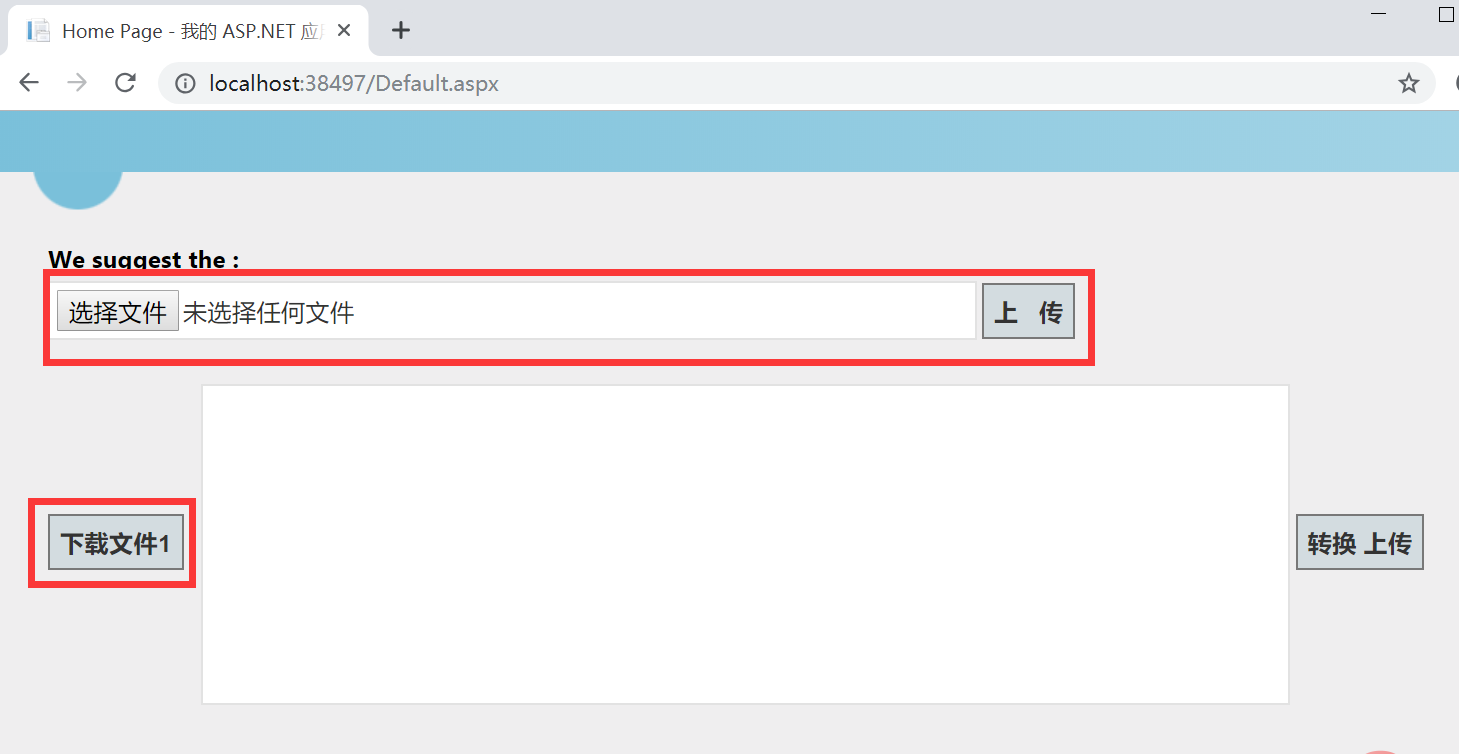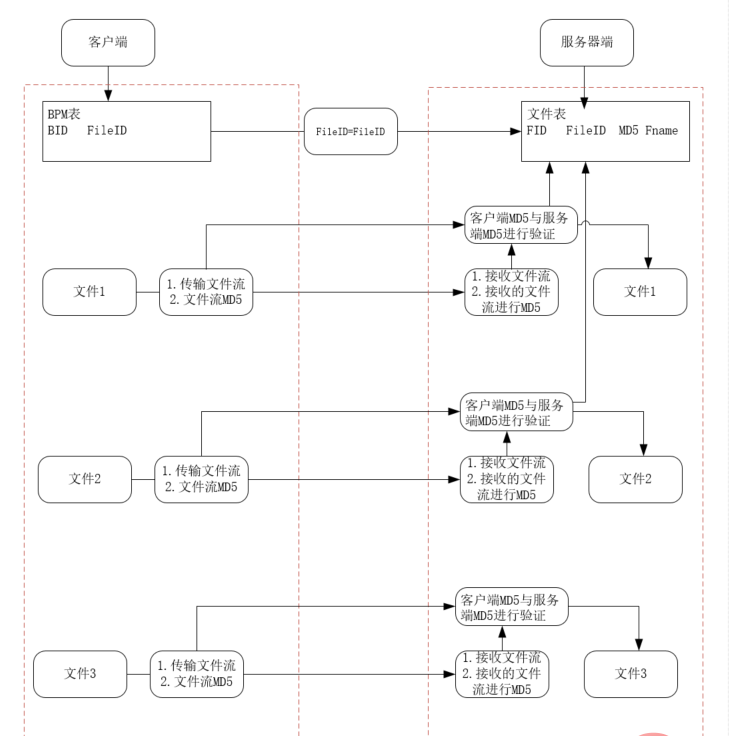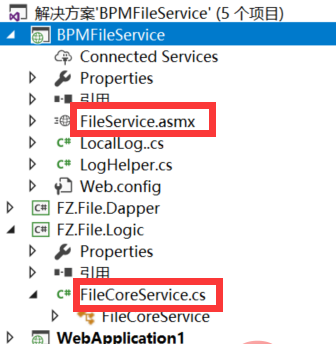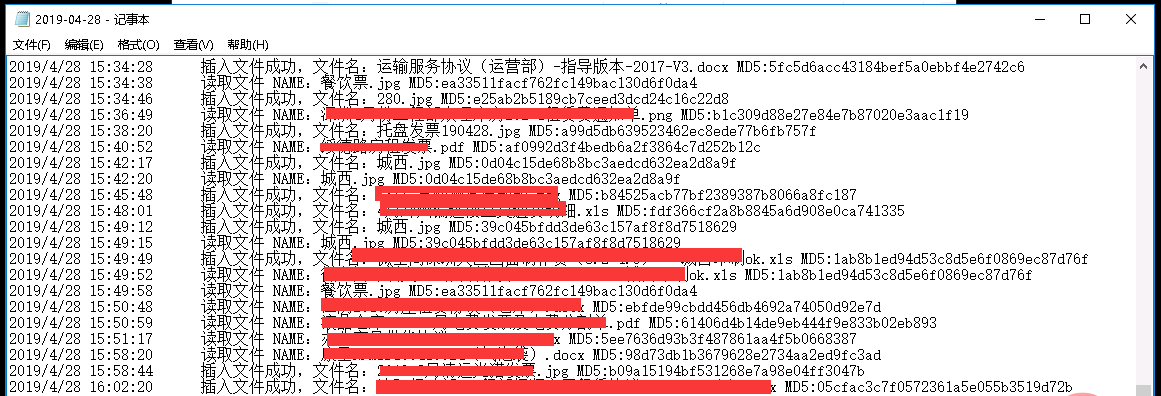C# 快速手动构建文件服务器
今天分享一篇关于自己手动搭建文件服务器的文章,非常方便,想拥有属于自己的文件服务器的朋友可以学习一下。
如下图,下面是调用的一个测试使用的界面。

测试上传和下载的功能。
相关教程:C#视频教程
基本原理说一下:
1.客户端上传file,转换成二进制流到服务器,服务器接收进行MD5加密,把文件及密码存入文件服务器库,文件根据MD5保存进本地文件夹,文件夹命名第一级取MD5前二位,第二级文件目录是MD5第3和4位,保存的文件重新命名,名称是当前加密的MD5。 当然,加密储存需要验证的,如果本地已经存了这个MD5就认为已经保存了相同的文件,就不需要再保存。
2.下载文件的时候 直接通过该MD5取文件即可。

上图是基本流程,逻辑上还是有漏洞,实际上又有改动。基本流程是这样了,可以大概看看,懒得再划一个图了。
服务端结构:

FileService.asmx 提供服务,核心代码在FileCoreService.cs. 本项目用的Dapper,简单方便、实用。
WebApplication1 就是测试用的,客户端调用的了。
WFBPMFile 可以忽略了,我的一个转换功能,原先文件是文件流存入数据库里的,大概100G,然后转换成文件,放入文件服务器了。
核心代码 放出来吧,喜欢的可以拿去.
using FZ.File.Dapper;
using System;
using System.Collections.Generic;
using System.Data;
using System.Linq;
using System.Diagnostics;
using System.IO;
using System.Security.Cryptography;
using System.Text;
namespace FZ.File.Logic
{
public class FileCoreService
{
/// <summary>
/// 根据文件名和MD5检查是否存在, 检查文件名和MD5都存在
/// </summary>
/// <param name="filename">文件名</param>
/// <param name="md5str">文件流加密的MD5</param>
/// <returns></returns>
public bool CheckFilNameMD5(string filename, string md5str)
{
using (IDbConnection conn = DBConfig.GetSqlConnection())
{
try
{
string sql = "SELECT COUNT(*) FROM BPM_tb_UploadFile WHERE [FileName]=@FileName AND FileMD5=@FileMD5 ";
//sql = String.Format(sql,filename,md5str);
//var count = conn.ExecuteScalar(sql, null, null, null, CommandType.Text);
var param = new DynamicParameters();
param.Add("@FileName", filename);
param.Add("@FileMD5", md5str);
var count = conn.ExecuteScalar(sql, param, null, 3600, CommandType.Text);
if ((int)count > 0)
{
return true;
}
}
catch (Exception ex)
{
throw ex;
}
}
return false;
}
/// <summary>
/// 验证数据的完整性(接收到的文件流MD5与接收到的MD5验证)
/// </summary>
/// <param name="md5str">接收的MD5</param>
/// <param name="sourceStream">文件流</param>
/// <returns></returns>
public bool CheckMD5(string md5str, System.Byte[] sourceStream)
{
var jmd5 = GetMD5HashByByte(sourceStream);
if (md5str == jmd5)
{
return true;
}
return false;
}
public bool InsertFile(System.Byte[] sourceStream,string md5str,string filename)
{
bool sf = SaveFileToDisk(sourceStream, "D:\\UploadFile\\", md5str); //先保存文件
if (sf)
{
//TO DO 插入数据库
using (IDbConnection conn = DBConfig.GetSqlConnection())
{
try
{
string sql = "INSERT INTO BPM_tb_UploadFile([FileName],[FileMD5],[FileSize],[Description]) VALUES('{0}','{1}',{2},'{3}')";
sql = String.Format(sql, filename, md5str, sourceStream.Length, "");
var count = conn.Execute(sql, null, null, null, CommandType.Text);
//var param = new DynamicParameters();
//param.Add("@FileName", filename);
//param.Add("@FileMD5", md5str);
//var count = conn.Execute(sql, param, null, 3600, CommandType.Text);
if (count > 0)
{
return true;
}
}
catch (Exception ex)
{
throw ex;
}
}
}
return false;
}
// 根据二进制流生成MD5
private string GetMD5HashByByte(System.Byte[] sourceStream)
{
MD5 md5 = new MD5CryptoServiceProvider();
byte[] result = md5.ComputeHash(sourceStream);
String ret = "";
for (int i = 0; i < result.Length; i++)
ret += result[i].ToString("x").PadLeft(2, '0');
return ret;
}
// 根据文件流生成MD5(与上一方法生成结果相同)
private string GetMD5HashByFile(string fileName)
{
FileStream file = new FileStream(fileName, FileMode.Open);
MD5 md5 = new MD5CryptoServiceProvider();
byte[] result = md5.ComputeHash(file);
file.Close();
StringBuilder sb = new StringBuilder();
for (int i = 0; i < result.Length; i++)
{
sb.Append(result[i].ToString("x2"));
}
return sb.ToString();
}
// 保存文件流到服务器上指定位置
private bool SaveFileToDisk(System.Byte[] sourceStream, string fileFullName)
{
bool result = false;
try
{
//待保存的路径
string savePath = Path.GetDirectoryName(fileFullName);
if (!Directory.Exists(savePath))
{
Directory.CreateDirectory(savePath);
}
using (FileStream fsTarget = new FileStream(fileFullName, FileMode.Create, FileAccess.Write, FileShare.None))
{
fsTarget.Write(sourceStream, 0, sourceStream.Length);
fsTarget.Flush();
fsTarget.Close();
result = true;
}
}
finally
{
}
return result;
}
private bool SaveFileToDisk(System.Byte[] sourceStream, string filepath,string md5)
{
bool result = false;
string fileFullName = filepath + md5.Substring(0, 2) + "\\" + md5.Substring(2, 2)+"\\" + md5;
try
{
//待保存的路径
string savePath = Path.GetDirectoryName(fileFullName);
if (!Directory.Exists(savePath))
{
Directory.CreateDirectory(savePath);
}
using (FileStream fsTarget = new FileStream(fileFullName, FileMode.Create, FileAccess.Write, FileShare.None))
{
fsTarget.Write(sourceStream, 0, sourceStream.Length);
fsTarget.Flush();
fsTarget.Close();
result = true;
}
}
finally
{
}
return result;
}
public System.Byte[] ReadFileByte(string filename, string md5str)
{
var filepath = "D:\\UploadFile\\" + md5str.Substring(0, 2) + "\\" + md5str.Substring(2, 2) + "\\" + md5str;
FileStream fileStream = new FileStream(filepath, FileMode.Open);
byte[] bytes = new byte[fileStream.Length];
fileStream.Read(bytes, 0, bytes.Length);
fileStream.Close();
return bytes;
}
public FileStream ReadFileStream(string filename, string md5str)
{
var filepath = "D:\\UploadFile\\" + md5str.Substring(0, 2) + "\\" + md5str.Substring(2, 2) + "\\" + md5str;
FileStream fileStream = new FileStream(filepath, FileMode.Open);
fileStream.Close();
return fileStream;
}
}
}上面保存的文件路径自己写入配置文件吧,还有日志文件路径,自己到配置文件改一下。代码写的很烂,各位高人忽略即可。
提供的服务代码:
using System;
using System.Collections.Generic;
using System.Linq;
using System.Web;
using System.Web.Services;
using FZ.File.Logic;
using System.IO;
namespace BPMFileService
{
/// <summary>
/// FileService 的摘要说明
/// </summary>
[WebService(Namespace = "http://tempuri.org/")]
[WebServiceBinding(ConformsTo = WsiProfiles.BasicProfile1_1)]
[System.ComponentModel.ToolboxItem(false)]
// 若要允许使用 ASP.NET AJAX 从脚本中调用此 Web 服务,请取消注释以下行。
// [System.Web.Script.Services.ScriptService]
public class FileService : System.Web.Services.WebService
{
[WebMethod]
public bool CheckMD5(string filename,string md5str)
{
FileCoreService fs = new FileCoreService();
return fs.CheckFilNameMD5(filename, md5str);
}
[WebMethod]
public bool InsertFile(System.Byte[] FileStream,string filename, string md5str)
{
FileCoreService fs = new FileCoreService();
bool b = fs.CheckMD5(md5str, FileStream); //验证MD5
if (b)
{
b = fs.InsertFile(FileStream, md5str,filename); //保存文件,并更新到数据库
if (b) { LocalLog.Write("插入文件成功,文件名:" + filename + " MD5:" + md5str); }
else { LocalLog.Write("插入文件失败,文件名:" + filename + " MD5:" + md5str); }
}
else
{
LocalLog.Write("接收的文件不完整,请检查!文件名:" + filename + " MD5:" + md5str);
}
return b;
}
[WebMethod]
public Byte[] ReadFile(string filename, string md5str)
{
FileCoreService fs = new FileCoreService();
Byte[] bytes = fs.ReadFileByte(filename, md5str);
LocalLog.Write("读取文件 NAME:" + filename + " MD5:" + md5str);
return bytes;
}
}
}客户端上传调用的代码:
protected void btnUp_Click(object sender, EventArgs e)
{
FileServiceSoapClient fsclient = new FileServiceSoapClient();
byte[] fb = FileUpload1.FileBytes;
System.IO.Stream s = FileUpload1.PostedFile.InputStream;
var md5str = GetMD5HashByByte(fb);
var md5str2 = GetMD5HashByFile(s);
var filename = FileUpload1.FileName;
bool b = fsclient.CheckMD5(filename, md5str);
if (!b)
{
if (md5str == md5str2) {
b = fsclient.InsertFile(fb, filename, md5str);
}
}
}客户端下载的代码:
protected void btndown_Click(object sender, EventArgs e)
{
FileServiceSoapClient fsclinent = new FileServiceSoapClient();
var Dbytes = fsclinent.ReadFile("新建文本文档.txt", "450ccb8dc556e010ff95b787084d2c51");
//byte[] bytes =byte.Parse(Dbytes.ToString()):
Response.ContentType = "application/octet-stream;charset=gb2321";
//通知浏览器下载文件而不是打开;对中文名称进行编码
Response.AddHeader("Content-Disposition", "attachment; filename=" + HttpUtility.UrlEncode("新建文本文档.txt", System.Text.Encoding.UTF8));
Response.BinaryWrite(Dbytes);
Response.Flush();
Response.End();
}数据库也比较简单:

日志:


以上就是C# 快速手动构建文件服务器的详细内容,更多请关注其它相关文章!
